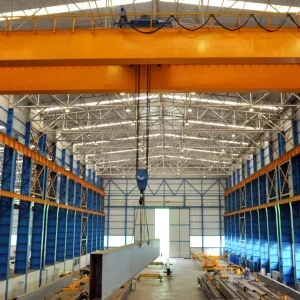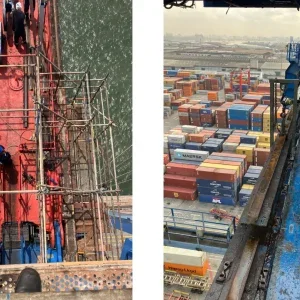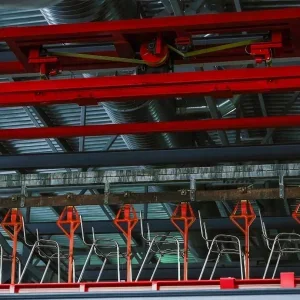In a mature market such as Europe, the lifting equipment supplied and used has reached a level where it is generally reliable, safe, and efficient. Pushing the technology forwards, then— and particularly in a sector where the basic physics of lifting are understood and not subject to change—requires innovations that improve convenience or meet the demands of specific, bespoke projects. Aldo Carozzi at Misia says: “Customers want more customised solutions. In the past, less than 5% of our business was in developing equipment for special projects, and it’s now around 20–30%.”
For Misia, which produces around 3,000 wire rope hoists a year, customised solutions can include hoists with long rope falls, curved monorails, special painting to meet IP66 demands, special outlet ropes, and more.
“Our customers are mainly crane manufacturers,” says Carozzi, “Any of whom could manufacture their own hoists. So we need to provide either the best price, or the ability to meet the requirements of their specialised projects.
“Many of these specialised hoists are used with standard bridge cranes for applications in engineering, such as underground construction, mining, and dams—all of which require long rope falls. “We can get tailored parts beginning from standard products, we modify motors and the body work of the hoists, which help us to produce specialised hoists. This process has been getting easier thanks to the experience we have gained in our long period in the hoisting market”.
Planeta has enjoyed a strong market so far in 2018, says Ralf Ullrich, sales manager at the company, with general growth across the industry driven by more investment in projects.
One of the company’s most interesting products is the JibFlex crane, which it distributes in Germany on behalf of the Danish manufacturer. It is made of a series of connecting lightweight aluminium sections that enables the operator to move the crane arm around obstacles.
“It’s designed for the offshore industry,” says Ullrich. “We can supply models up to 7m long. The capacity for a 7m unit is 150kg, increasing to 500kg for a 3m model.”
The company also showcased its aluminium mini lever hoist at Logimat, designed to be compact enough to fit in any tool case, says Ullrich. Models from 250kg capacity up to 3.2t are available, along with drill-powered hoists in 250kg and 500kg models.
Finland-based Erikkila is receiving an increasing number of orders in a market that is strong and growing, says Sanna Lempiäinen, sales and marketing director, with the German automobile sector being one of the big players for the company. Demand has been driven partly by new technology developed by the company, including its inverter-controlled crane. Not only does the inverter offer smooth acceleration and deceleration and reducedswing capability, when the crane is stopped, it becomes fully manual.
“Customers love it,” says Lempiäinen. “The electrical drive was developed in-house, and it can be used for fine tuning of positioning, or for manoeuvring empty loads.”
The company, which produces light cranes available in capacities up to 2t, has also developed an internal conductor option for its aluminium jib cranes. The advantages of this, explains Lempiäinen, are offering a safe system that can’t get stuck, as external equivalents can do, and doesn’t limit the movement of the crane. The light weight of the internal conductor rail also reduces friction.
Vetter has developed its Ergoline crane system—a flexible, modular system with adjustable pillars, to enable the user to make final adjustments to counter uneven floors. The pillars are made of steel and the runway and beam are aluminium, with the system available with capacities up to 1t. The runway and Cardanic bearings allow the operator to walk with the load running slowly behind them, says Bert Van Den Bril, area export sales manager at Vetter.
The launch of the Ergoline at Logimat followed a boom in business, says Van Den Bril, particularly with customers in the Middle East—with Vetter’s ATEX range of products selling especially well. Belgium and the Netherlands were also doing well, although have been calmer since February.
SWF Krantechnik, based near Mannheim, north of Stuttgart, showcased its Nova Silverline and Nova Blackline electric wire rope hoists, alongside its Chainster electric chain hoist, and explosion-proof hoists. The Nova Silverline range is designed for loads up to 80t and combines a range of features, including optimal hoist approach distance, a rope drum with extralarge diameter to reduce rope wear, low headroom, minimal lateral hook movement, and minimal load swing thanks to the use of frequency inverters. The Nova Blackline offers a more basic version of the Silverline but with the same advantages, and is available in capacities from 2t–20t.
The Chainster hoists cover loads from 63kg–5,000kg, and as well as the standard features also incorporate a cross travel frequency inverter drive, overload protection and non-contact limit switches to increase the precision of movement. All of SWF’s electric wire rope and chain hoists, and crane components, are available in explosion-proof versions.
Demag introduced the LDC-Q quadro chain hoist at Logimat, a hoist fitted with four hooks and designed to allow different load handling attachments to be lifted and transported and the same time.
Able to carry loads up to 3.2t, the LDC-Q is suitable for a wide range of production and logistics applications, including handling and transporting customer-specific load handling attachments or flat components and feeding materials to workstations.
This is based on the capabilities offered by Demag’s LDC-D double chain hoists. For example, the system can be set up to combine two double chain hoists that only have one drive, leading to one chain hoist motor transferring power to the other three chain lead-offs, creating mechanically synchronised hook lead-offs that supply uniform and more precise load handling.
Asymmetrical weight distribution up to a ratio of 70:30 can be handled, says the company. The system also incorporates Demag’s ProHub integrated variable speed control, which permits rated speeds of up to 90% higher in the partial load range. The quadro also offers fast and simple maintenance, adds Demag, due to its modular design.
Also on show at Demag’s stand was its rope control system, for checking the alignment and height of ropes using a laser and camera system—enabling operators to conduct pre-emptive maintenance. Across Logimat were innovations and new pieces of equipment. Stroedter highlighted its RollyxPlus+ aluminium rail system with integrated energy supply, improving safety and reducing the space and assembly time required.
Zasche showcased its jib crane with carbon-fibre arm, designed to be strong but lightweight, and its specialised gripper attachments. It is currently engineering systems for a range of companies, particularly in the automobile sector.
RUD promoted its drive technology along with its range of hooks and chains. The company offers RFID chipping in all of its components, to enable easy storage of and access to maintenance and product information. Another innovation is the Plus 12 material for manufacturing chains, which due to its increased strength produces chains with the same diameter as previous models, but with higher capacities.
Italy-based Indeva showcased its range of Liftronic electric manipulators. The Liftronic Easy is the smallest in the range, but includes a number of benefits including maintaining the load at a steady height if weight is added or removed, and ‘float mode’ through which the operator can lift the load using the load itself. Also developed by Indeva is the Liftronic Air pneumatic manipulator, with adjustable air pressure for different loads to ensure the load stays at the same height.
The company also produces monorail systems and a range of standard and customised tooling, including vacuum lifters, hooks, and so forth.
THE EUROPEAN MARKET
In Turkey, CMAK Crane Systems has seen business increase, in part driven by innovation, says export manager Aybars Kaya. “Industrial investments have been increasing in Turkey despite the economical and political fluctuations,” says Kaya. “CMAK Crane Systems increase the sales rates at the maximum level every year, thanks to continuous R&D, sales, marketing and aftersales activities.”
Domestic and international sales are split equally, says Kaya. In its domestic market CMAK mostly reaches end customers directly, whereas for international sales, CMAK works through a network of partners.
“CMAK currently has partners in six continents and 30 countries,” says Kaya. “North and South America, China, Russia, Italy and UK are some of the most active regions nowadays.
“CMAK also has a sales office and warehouse located in Elk Grove Village, Illinois which stores ready-products such electric wire rope hoists with crane components and spare parts to provide better, responsive, and fast delivery for the partners.”
The R&D performed by CMAK includes digitalisation, one of the current key drivers in crane innovation.
“Our HoistSense+ electronic control unit is an Industry 4.0-integrated expandable version of upgraded HoistSense.
HoistSense+ can integrate into a generic industrial wi-fi or mobile data router and connect to the internet to start the flow of information securely to CMAK cloud servers to monitor and create reports and alarms monthly and annually for the users in real-time. In other words, HoistSense+ is a supervisor with artifical intelligence of the cranes and boosts the performance of the cranes, by informing end users when to replace brake linings, when there is a requirement for training, and exactly what is happening on their cranes.
“Customers are interested with the trend ‘Industry 4.0’ or ‘Internet of things’ nowadays,” says Kaya. “The implementation of technology influences the values of a society by changing expectations and realities. HoistSense+ is a business intelligence that focuses on meeting customers’ demands, giving the best return on investment and best endurance in the world market. “We take data security very seriously. This is one of the distinguishing features of HoistSense+—it does not accept connections from the internet, in other words there is only one way to access HoistSense+ for calibration and adjusting, and that is by direct wired connection to its hardware.
“We are also nearing completion of releasing the new CMX Series Wire Rope Hoist in the last quarter of 2018. This is a new series of wire rope hoists to have more advantages with making it ready for nextgeneration speed regulations.”
Eepos, a manufacturer of lifting equipment including monorail systems and jib arm cranes, has enjoyed a strong performance in central Europe for many years. It is using that success as a foundation for more innovation, says Marcus Walter, head of marketing.
“Central Europe has always been a strong area for eepos and despite various uncertainties in some European countries our company has been growing on average at double-digit rates in these markets for several years.
“We are currently working at maximum production capacity and expanding our aluminium modular crane and profile system ranges to ensure that the demands of crane systems in the increasing use of factory digitisation can be met.
“We are also innovating solutions where a wide variety of media such as electricity, compressed air, water and other volume flows on the plant floor are required and can be delivered through our advanced ‘eepos base’ aluminium media columns. “As an addition to the crane applications, we have designed a flexible and innovative power supply called ‘eepos powertrack’. This can, for example, be plugged directly onto the aluminium profiles of the crane runway to provide energy quickly and safely at any point in production via various module boxes.
“The trend towards plant digitisation in the automotive sector, mechanical engineering and other manufacturing sectors is providing many sales opportunities for innovative material handling companies such as our own, where our products work seamlessly in a fully automated production environment. For example, our ‘eepos one’ modular system in the load range up to 2,000 kg or our ‘nano’ system designed to handle loads and tools up to 75kg means that the increasing demands of crane systems in a digitised production environment can be answered. “Our innovations in ‘portable energy’ and ‘multi power supply’ are providing highly efficient and cost-effective solutions for the digitised factory.”
Developing new technology has also given the company a foothold outside of Europe, says Walter. “Innovation has always been at the forefront of everything that we do at eepos, and we believe that this has contributed greatly to our success in the Asian market, where our penetration has grown steadily over the past years.
“Equally, and despite short-term political uncertainties, we are extremely active on the American continent due to many long-term projects that are in our customers’ pipelines.” Thomas Kraus at Stahl CraneSystems references another political uncertainty, although overall says the European market is healthy: “Business is currently doing pretty good—overall there are strong markets, in terms of both offers and orders. “We are quite confident in expecting strong markets in the short-term and midterm view. But it always depends on the economy, especially how the trade dispute between America and China will end.”
RUD has also seen solid growth in Europe, although the market is always changing, says Yasin Kartal, area sales manager for conveyors and drives: “The market is really good in Europe, and is growing. But it can be hard to predict what will happen in the next three or four months, so you can only plan for a short time ahead.
“There are lots of changes taking place— some political, some regulatory—in industries such as the automotive sector, where laws regarding fuel types are evolving.”
Kito has been doing business in central Europe from its office in Düsseldorf for 11 years, says Eugen Wagorowski, export area sales manager, and now has a team of around 40 staff there.
“We provide training for service staff and the sales team from the office,” says Wagorowski. “Central Europe is a difficult market as there are a lot of competitors, but we focus on high quality and safety, and on our network of dealers. We have around 700–800 partners in Europe, and all of them have the potential to grow—for example one of our partners in Slovenia is now selling around ten times the value of equipment they were selling two years ago.”
Gorbel, a very well-established manufacturer of material handling equipment in the USA, is relatively new to the European market. The company is expanding in Europe through a distributor network, one of whom is German company Expresso, a specialist in lifting systems.
“We are relatively new in Europe but are expanding coverage with key distributors across Europe . We are the market leader in the US and want to understand the European customer requirements and help our customers more effectively there,” says Paul C. Lam, vice president of international operations at Gorbel. “Our initial business in Europe has tended to the US companies with facilities in Europe, while they are familiar with the Gorbel product features and benefits. As more customers find out we are represented locally with the best distributors in Europe, we have received increasing interests about our G-Force among European manufacturers as well.
“The intelligent lifting device sector is doing very well. There is a changing trend towards electrically-powered lifting systems though, which is where Gorbel comes in as our G-Force is considered the best in the industry. The G-Force provides the most advanced and proven technology that is designed to assist operators who desire to handle a variety of loads with the least effort.”
As well as distributing Gorbel products, Expresso manufactures its own pneumatic balance stand. What’s interesting about the product is that it’s moveable, and doesn’t need fitting to the factory floor. The vacuum lifting system has adjustable height, and capacities up to 100kg. The company also produces fully-customised attachments, available in different shapes and sizes and suitable for lifting, turning and moving.
German-based 3i also produces vacuum lifting equipment, amongst its wide range of fully-modular lifting kit. The ‘Basic’ lifting attachment is designed to be extremely quiet, which is particularly useful when multiple vacuum handlers are in use at the same facility at the same time.
The company has a team of around 280 people across the whole group, and sells its range of lifting and handling equipment to 25 countries, says Christian Viehmann, managing director at 3i. Its portfolio also includes the MobiCrane, a jib crane with capacity up to 85kg, and light material handling equipment with capacities mostly around 10kg-250kg.






